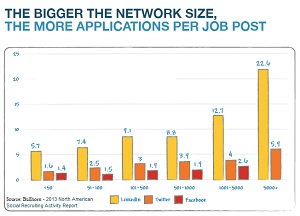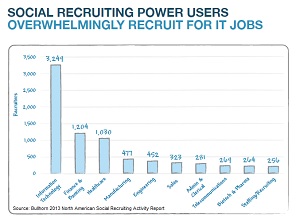If you’re beginning to think every one is using LinkedIn to source candidates, you’re close to right.
Nearly every survey on source of hire or use of social media by recruiters shows LinkedIn to be a key part of the mix; often it leads all the listed social media sites. The company itself reported adding 2,400 customers in just the last quarter of 2012, bringing the total to 16,400 organizations under contract.
Now comes a Bullhorn survey to report that of the 160,000 registered users on Bullhorn Reach, 97 percent use LinkedIn to source candidates. That’s not as surprising as it might seem at first glance.
Two-thirds of recruiters use only LinkedIn
Bullhorn Reach is a “freemium” site specifically for managing a social media program and posting jobs to the sites and to some job boards. Bullhorn Reach users are all committed to at least some level of social media interaction.
 Yet, so strong is the draw of LinkedIn, that almost two-thirds of the Bullhorn Reach recruiters use nothing but the business network to find candidates. Far fewer are exclusive to either Facebook (2 percent) or Twitter (1 percent). Instead, these two networks are used in addition to LinkedIn.
Yet, so strong is the draw of LinkedIn, that almost two-thirds of the Bullhorn Reach recruiters use nothing but the business network to find candidates. Far fewer are exclusive to either Facebook (2 percent) or Twitter (1 percent). Instead, these two networks are used in addition to LinkedIn.
Those who do use all three, the so-called power users who represent only 12 percent of the Bullhorn Reach registrants, tend to be the niche recruiters. Those who recruit for IT are by far the most numerous.
Bullhorn says 3,249 are IT recruiters, which makes sense considering how competitive it is to find tech talent. However, finance and banking recruiters are second on the power list; this is explained, perhaps, by the larger number of early-career jobs they have for which Twitter and Facebook may be better targeted sites.
The LinkedIn influence is also reflected in the size of recruiter networks. Of the three major social networks included in the report, LinkedIn has more North American recruiters with large networks than either Twitter or Facebook. More than 20 percent of the Bullhorn Reach recruiters have more than 1,000 contacts in their LinkedIn network.
The average for recruiters in the U.S. and Canada is 692 LinkedIn connections.
Twitter, Facebook lag considerably
Facebook, which has about five times as many registered members as LinkedIn, is far behind in recruiter use. Twitter is even further to the rear, with half the Twitter recruiters having fewer than 50 followers. Only 2 percent have networks in the 1,000-2,000 follower range. On Facebook, 3 percent have that many connections; the majority, though, have fewer than 500, and 26 percent have under 200 Facebook friends.
The Twitter average is 290 followers. On Facebook, recruiters average 251 friends.
About Facebook, the report says:
Its perception as a purely personal tool and the lack of awareness of its targeting features (such as friend lists) may account for why recruiters haven’t yet fully embraced it. However, our research indicates that it works better than Twitter for identifying place-able candidates.”
Bullhorn’s 2013 North American Staffing and Recruiting Trends Report (and you can get a copy here) shows that while 22 percent of recruiters on Bullhorn reach use Facebook, versus 27 percent who use Twitter, Facebook produced more placed candidates. According to the report, 16.7 percent of recruiters successfully used Facebook to place candidates versus just 12.7 percent with Twitter.
Any way you cut is, LinkedIn produces more
However, 92.9 percent of recruiters reported LinkedIn produced candidates they placed.
Job postings on LinkedIn also got many more views (179 per) than they did on Facebook (10) and Twitter (45) combined. And LinkedIn yielded more job applications per job application than did either Facebook or Twitter.
Even when the size of the network — connections, friends, or followers — is factored in, LinkedIn is still the bigger producer by multiples. As you might expect, the bigger the network, the more applications each job posting gets.
For Twitter and Facebook, those numbers rise slowly; on Linkedin, even recruiters with fewer than 50 connections average 5.7 applications for each job they post. Those with mega networks of 5,000 or more get 22.6 applications.
On Twitter and Facebook, no matter how large the network, the average number of applications maxes out at just under six.
